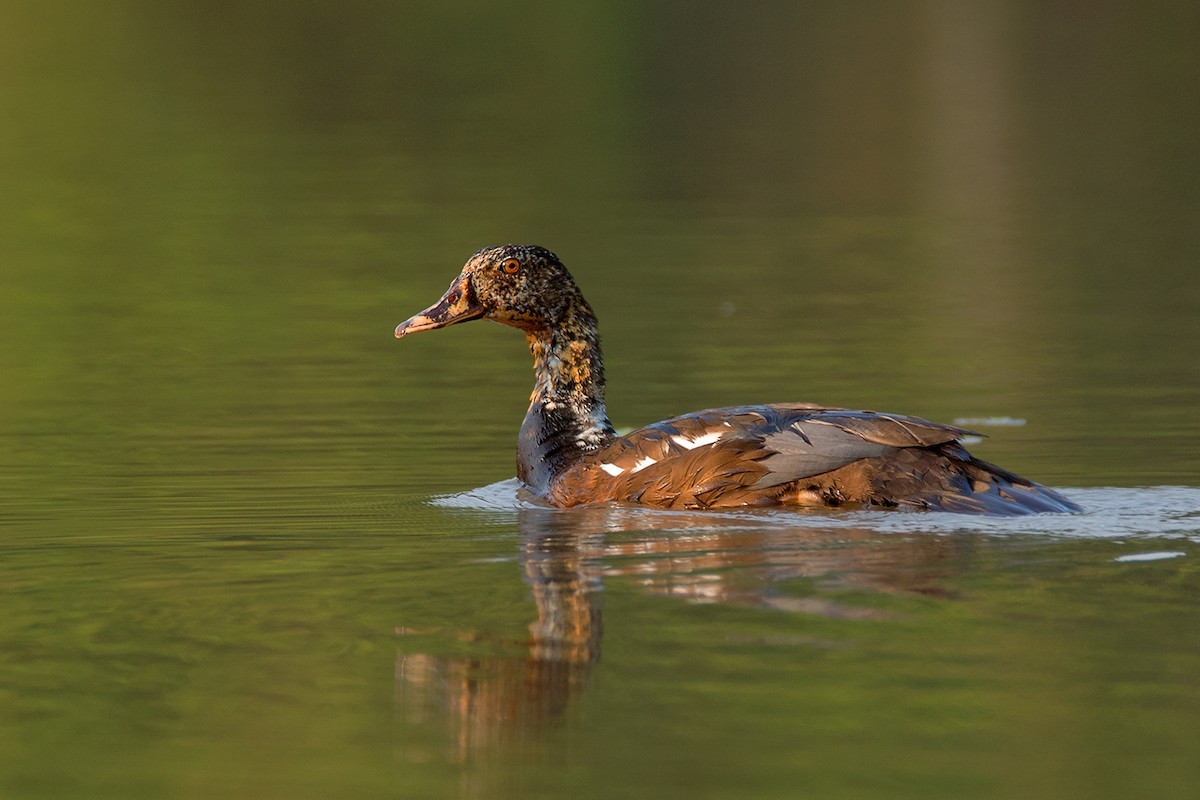White-winged Duck
A species of Duck Scientific name : Asarcornis scutulata Genus : Duck
White-winged Duck, A species of Duck
Botanical name: Asarcornis scutulata
Genus: Duck
Content
Description General Info
 Photo By Ayuwat Jearwattanakanok
Photo By Ayuwat Jearwattanakanok Description
This is one of the largest living species of duck next only to the steamer ducks which are heavier. The Muscovy duck also attains sizes that nearly rival the white-winged duck, but may average a bit smaller in a wild state. Length is 66–81 cm (26–32 in) and wingspan is 116–153 cm (46–60 in). Males weigh 2.94–3.9 kg (6.5–8.6 lb), while females weigh 1.95–3.05 kg (4.3–6.7 lb). The most noticeable feature on adult birds, is the dark body contrasting with a whitish head and neck. Males have mostly dull yellowish bill, blackish mottling on the head and upper neck, white lesser median coverts and inner edges of tertials and bluish-grey secondaries. In flight, white wing-coverts contrast with the rest of the wings. Females are smaller and usually have more densely mottled head and upper neck. The juvenile is duller and browner. This secretive species is only known to feed at night. Its diet consists of seeds, aquatic plants, grain, rice, snails, small fish and insects. It inhabits stagnant or slow-flowing natural and artificial wetlands, within or adjacent to evergreen, deciduous or swamp forests, on which it depends for roosting and nesting, usually in tree holes. Although lowlands (below c.200 m) provide optimum habitat, it occurs up to 1,400 m of altitude, especially on plateaus supporting sluggish perennial rivers and pools. 
Size
81 cm
Nest Placement
Tree
Feeding Habits
White-winged Duck dabbles and head-dips for seeds, aquatic plants, grain, molluscs, insects, spiders, and small vertebrates. They show variability in daily feeding rhythms, with activity peaking at dawn, dusk, and occasionally night-time. Unique in their occasional diving behavior and group foraging, they exhibit a morning feeding preference.
Habitat
White-winged Duck predominantly resides in secluded tropical evergreen rainforest, particularly within dense freshwater and peat swamp forests. Their habitat extends to marshes and quiet pools, which they use for feeding, and includes deep forest ditches with water and permanent swamps, especially during the dry season. They also adapt to spend time in deciduous forest swamps and occasionally rice paddies.
Dite type
Omnivorous
General Info
Feeding Habits
Bird food type
Distribution Area
Historically, the white-winged duck was widely distributed from northeastern India and Bangladesh, throughout South East Asia to Java and Sumatra. It is now extinct in Java. In India, the duck is found only in the northeastern part of the country, with the main concentration in eastern Assam and adjacent areas of Arunachal Pradesh. However, in 2002 it had a population of only 800, with about 200 in Laos, Thailand, Vietnam and Cambodia, 150 on Sumatra, notably in Way Kambas National Park and 450 in India, Bangladesh and Burma. In India, the key protected areas for the white-winged duck are Dibru-Saikhowa National Park, Dihing-Patkai Wildlife Sanctuary, Nameri National Park and Namdapha National Park. The white-winged duck occurs in dense tropical evergreen forests, near rivers and swamps. They tend to nest in tree cavities, and are threatened in part since the destruction of hollow trees is destroying their nesting localities. The draining of swamps and rivers and other forms of habitat destruction is also destroying the habitat that they could survive in. Additional threats include loss of genetic variability, disturbance, hunting, and collection of eggs and chicks for food or pets. Due to ongoing habitat loss, a small population size, and because this duck is hunted for food, eggs and pets, the white-winged duck is evaluated as Endangered on the IUCN Red List of Threatened Species. It is listed on Appendix I of CITES. The white-winged duck is also found in the central Sumatra province of Riau, specifically in the peatland Acacia plantations of a large pulp and paper company. The plantations, at least temporarily, provide suitable habitat between periodic harvests (once every 4–5 years). The ducks are frequently observed along canals where large and overhanging Acacia trees provide shade and cover from predators and a haven in which to feed and rest. The quiet and still water in the canals of the plantations provides an undisturbed and secluded location, away from local communities which may hunt the ducks or collect their eggs. Nearby, natural forest conservation areas and greenbelts also provide suitable nesting and roosting habitat in close proximity to the canals. It is the state bird of the Indian state of Assam. 